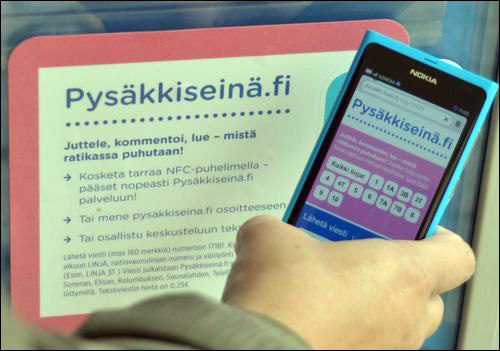Customers of the nine transit lines operated by Helsinki Region Transport (HRT) can now employ Near Field Communication (NFC)-enabled mobile phones to pay for tickets, as well as post messages to other passengers and the transit authority, online. The pilot, known as Pysäkkiseinä—which translates as “Tram Stop Wall”—utilizes TagAge RFID technology provided by Hansaprint. The six-month pilot ended on Dec. 1. However, the tags are still in use, and the agency is currently reviewing the results and considering whether to make the installation permanent, and whether to expand it.
The technology was being tested in order to determine whether NFC tags could make commuting via HRT’s streetcars more convenient and enjoyable—by enabling ticket purchasing onsite, as well as providing some entertainment in the form of a virtual wall on which travelers could post messages. However, it could also provide a service for HRT, by allowing commuters to post information about the trams, including whether they are on time, and suggestions for how the schedule might be improved.
HRT is now reviewing the data collected during the pilot, in order to determine how often the tags were interrogated, as well as when and where this occurred, says Susanna Ollila, the project planner at Forum Virium Helsinki, an organization established by that city in 2005. Forum Virium Helsinki develops new digital services in cooperation with businesses, public-sector organizations and the city’s residents. Its members include handset manufacturer Nokia and telecommunications solutions provider TeliaSonera. HRT contracted Forum Virium Helsinki to oversee the pilot. The company may opt to expand the solution to other tram stops if it determines that the technology provided a benefit to commuters, as well as to HRT itself. Nokia provided consulting services related to how NFC phones would operate with the system, while media company Sanoma Group‘s Metro Newsletter division manages the wall on which the messages are posted.
For the Pysäkkiseinä pilot, Hansaprint selected labels, and then printed and encoded each label’s Smartrac BullsEye NFC RFID tags, which typically sell for about €0.90 ($1.18) apiece. In September 2011, HRT launched the pilot, attaching two BullsEye NFC labels, each containing an NXP Semiconductors NTAG203 RFID chip, to the walls of 211 covered tram stops.Helsinki Region Transport already enables commuters to purchase tickets using their mobile phones. Travelers can simply input an SMS code and send it as a text message in order to request the ticket. The ticket is then sent to the user’s phone, and that individual receives a charge on his or her wireless phone bill. Although that system worked well, Ollila says, establishing an NFC connection between the phone and HRT’s ticketing office made the transaction simpler, without requiring users to press a series of numbers on a keypad. Instead, they can simply walk up to the NFC sticker and tap the phone against the tag. The tag ID is interrogated by the NFC reader built into the phone, and the phone sends a text message directly to the server specific to that tram line, along with the phone’s own unique identifier. The transit company can then authorize the ticket, which is displayed on the phone’s screen, and charge the phone number from which the message was sent. Because the tag is encoded with the text message contact related to the purchased ticket, the user need not press buttons on the phone.
The second sticker installed at each tram shelter is designed to facilitate communication with other riders, as well as with the transit company. While awaiting the next streetcar, a commuter can tap his or her phone against the second sticker, which is encoded with the URL of the Pysäkkiseinä Web site specific to that tramline. The phone’s Web browser then displays the Web site, and the user is invited to begin inputting comments, as well as view others’ messages.

The message wall has been used in a variety of ways, HRT reports. For example, riders can post messages regarding the service—for instance, to indicate if a tram is running late. If a commuter has accidentally left a scarf or other personal item on a tram, that person can post a message to the wall describing the item, and provide contact information in case anyone finds its. There is a social side to the service as well, Ollila says: Those too shy to introduce themselves to someone whom they see on the tram can instead post a message on the wall, indicating a desire to meet. The technology also takes the place of graffiti, allowing would-be writers or artists to express themselves on the virtual wall, rather than defacing transit property.
The Metro Newsletter’s staff acts as moderators, viewing and approving messages before they are posted. This helps to ensure that offensive comments are not made public.
Ollila does not yet have details about the number of times NFC technology has been used as opposed to using SMS to purchase tickets or using a phone’s Web browser to manually navigate to the Pysäkkiseinä Web site to post or read messages.



